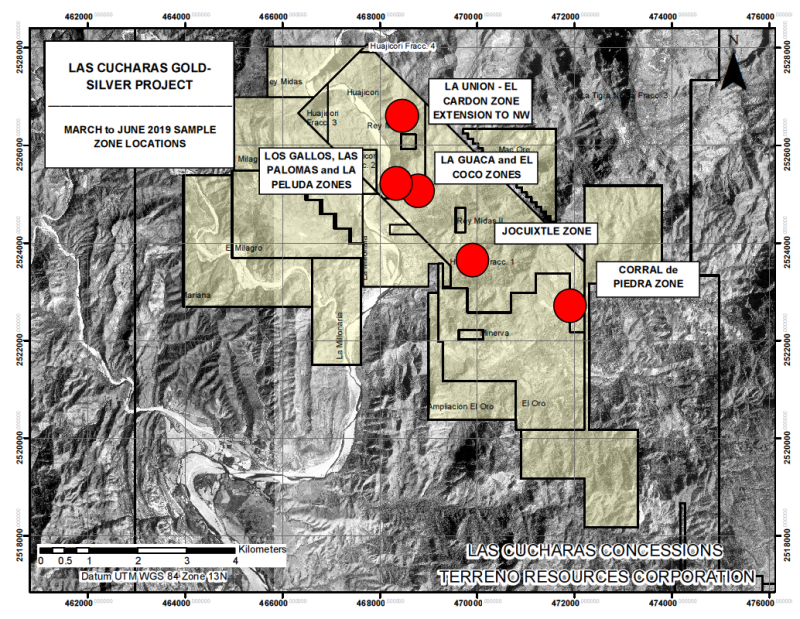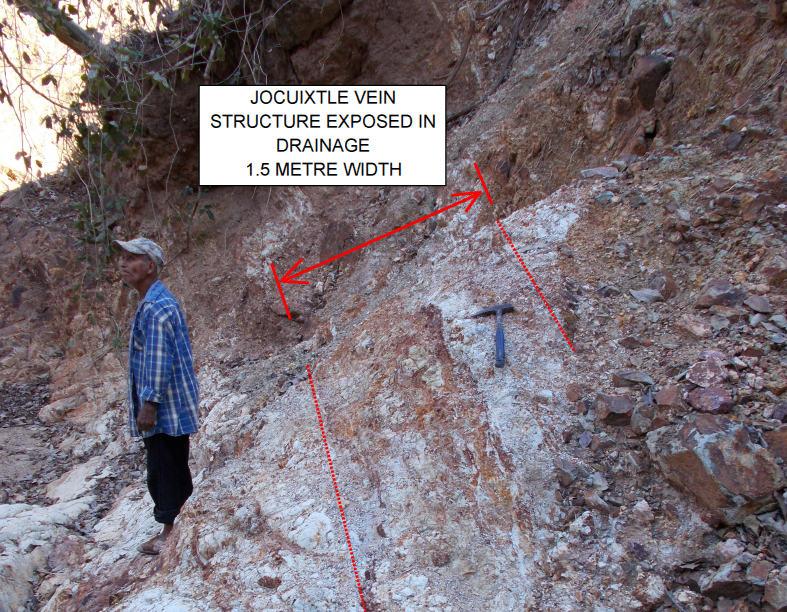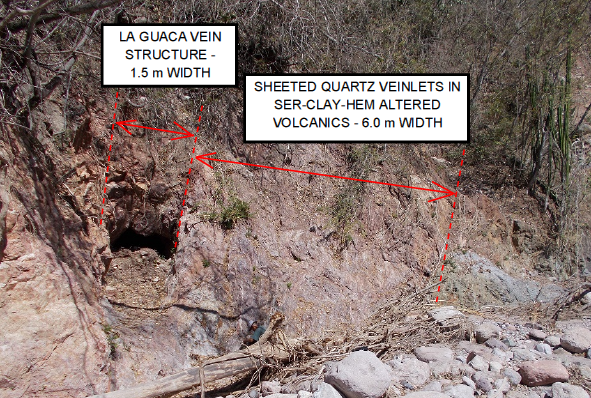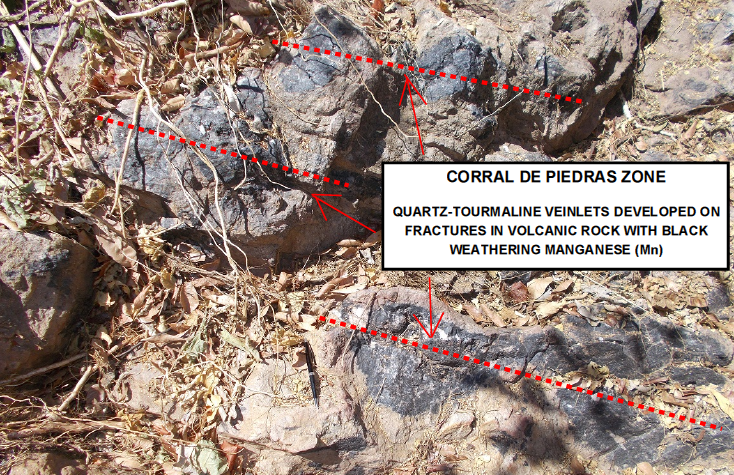(via TheNewswire)
TORONTO, CANADA - TheNewswire - February 18, 2020 - Terreno Resources Corp. (TSXV:TNO.H) ("Terreno" or the "Company") George A. Brown, President & CEO, is pleased to announce that the 2019 exploration programs at the Las Cucharas Gold and Silver Project ("Las Cucharas") in Nayarit, Mexico, sampled and identified several new mineralized zones.
The Las Cucharas represents a historic gold and silver mining area with well documented small-scale production from 1903 through 1961 of 3,000 kilograms of gold and 30,000 kilograms of silver (Vargas, 1994, COREMI Pub M-12e). It is located in the southern extreme of the mid-Tertiary Sierra Madre Occidental (SMO) volcanic belt, which hosts many of Mexico's gold and silver deposits. The Las Cucharas is considered a low-sulfidation epithermal precious metal system with significant mineralization occurring along a six kilometre northwest-trending structural zone. The project area consisting of 4,447 hectares is located on seventeen (17) concessions.
In 2018, the planned exploration programs were severely hampered by an unusually strong hurricane season which brought three separate force-five hurricanes and many tropical storms to the region. High rainfall and strong winds resulted in landslides, blocked roads, washed out bridges, and high river levels. Repairs to project access roads were carried out by Terreno from January to March 2019 with a D6 cat. A significant exploration benefit from the extreme weather has been the creation of several new outcrop exposures.
The 2019 exploration programs at Las Cucharas continued to provide additional evidence of a widespread hydrothermal precious metal system with greater size potential and continuity than was previously indicated. Company geologists are focused on a regional and property-wide interpretation of the structural controls on gold and silver mineralization with the intention to develop a reliable geological model for generating potential drill targets. A total of ninety (90) samples were collected from new outcrop exposures. Map 1 indicates the locations of the new sampled zones (SEE MAP 1).
1. La Union - El Cardon Zone
The La Union and El Cardon Zones are sub-parallel vein structures which have been traced over 800 metres in strike length. These zones have significant underground development on several levels and were major contributors to gold and silver production at Las Cucharas.
New exposures have been sampled to the northwest, southeast, and west of the main mineralized zones. Extensions of the structures are typically 1.5 metres in width where exposed, and consists of intense quartz veinlets in a strongly silicified fault breccia matrix. Limonite and hematite iron oxides are common, and pyrite is locally visible.
Sample highlights from the Veta La Amapa (Amapa Vein) are shown below. This structure has not been sampled previously and is located over 150 metres to the southwest of the main La Union structure.
|
Sample Number
|
Sample Width (m)
|
Au (g/t)
|
Ag (g/t)
|
|
40077
|
1.50
|
0.45
|
119.1
|
|
40078
|
1.30
|
3.61
|
248.0
|
2. Jocuixtle Zone (SEE PHOTO 1)
Jocuixtle is part of the northwest-trending La Italia-Jocuixtle-La Taverna-Los Gallos vein system, which has been traced over 1.2 kilometres, and was an important contributor to historic gold and silver production at Las Cucharas. The main underground working is collapsed and not currently accessible.
The main Jocuixtle structure is a combination of clay-rich fault or sheared volcanic rock with abundant quartz veins and veinlets, and ranges from 1.5 to 4.6 metres wide where exposed. The wallrock typically has fine quartz veinlets and strong clay-sericite alteration with fine disseminated pyrite. Fine disseminated galena and malachite staining occur locally, and hematite and limonite iron oxides are common. The first two samples below represent mineralized wallrock, and the following samples represent vein material.
|
Sample Number
|
Sample Width (m)
|
Estimated True Width (m)
|
Au (g/t)
|
Ag (g/t)
|
|
40080
|
1.40
|
|
1.17
|
106.4
|
|
40081
|
1.50
|
|
-
|
38.3
|
|
40092
|
1.00
|
|
0.14
|
224.0
|
|
40095
|
2.00
|
2.00
|
0.22
|
92.6
|
|
40096
|
1.30
|
1.30
|
3.39
|
710.0
|
|
40099
|
1.50
|
1.50
|
-
|
24.8
|
3. La Guaca and El Coco Zones (SEE PHOTO 2)
The La Guaca Zone is located to the northwest and is thought to be the northern continuation of the La Italia-Jocuixtle-La Taverna-Los Gallos vein system, with a cumulative length of 1.2 kilometres.
The main La Guaca structure in this exposure is 1.5 metres wide with a north-west orientation consisting of drusy quartz veins, calcite veinlets, and abundant iron oxides. Lateral and parallel to the main structure are sericite-clay-calcite alteration zones with fine disseminated pyrite and abundant iron oxides, which in turn, changes outward to propylitic epidote-chlorite-calcite alteration, and then to relatively unaltered intermediate volcanic rock. The main structure and lateral alteration zones are greater than 16 metres in true width. A previously unknown adit is now exposed and follows this structure.
|
Sample Number
|
Sample Width (m)
|
Estimated True Width (m)
|
Au (g/t)
|
Ag (g/t)
|
|
40101
|
1.50
|
|
-
|
10.6
|
|
40102
|
1.50
|
1.50
|
0.14
|
15.9
|
|
40109
|
1.50
|
|
0.76
|
61.6
|
|
40110
|
1.75
|
1.75
|
0.27
|
44.9
|
|
40111
|
1.20
|
|
0.35
|
42.4
|
The El Coco Zone is a newly discovered vein exposure approximately 800 metres to the east of La Guaca with a collapsed underground working. The vein structure indicates a northwest strike, is 1.5 metres wide, and consists of abundant quartz veinlets in a fault breccia matrix.
|
Sample Number
|
Sample Width (m)
|
Estimated True Width (m)
|
Au (g/t)
|
Ag (g/t)
|
|
40113
|
1.50
|
1.50
|
0.20
|
62.7
|
|
40114
|
1.60
|
|
-
|
9.5
|
|
40115
|
1.00
|
|
1.26
|
132.9
|
4. Corral de Piedra Zone (SEE PHOTO 3)
The alteration and mineralization style at Corral de Piedra appears very similar to that of the El Molino Zone, and is located approximately 1.5 kilometres to the east-northeast of El Molino. Both zones are located near to the southeast extent of the project area.
At El Molino, gold and silver values are associated with predominantly northeast-trending banded quartz and quartz +/- tourmaline veins, veinlets, and breccias with a characteristic black weathering from a manganese-rich mineral assemblage. Surface sampling from previous operators over a 100 x 380 metre area reported values of 1.13 g/t Au and 143 g/t Ag over 3 metres, with individual samples ranging up to 4.84 g/t Au and 95.4 g/t Ag. Precious metal mineralization in this area appears to be widespread due to the intersection of fault and fracture systems with different orientations.
Several new exposures have also been identified in the 1.5 kilometre area between El Molino and Corral de Piedra with similar alteration and mineralization styles.
New exposures at Corral de Piedra have been traced over a 100 metre long area and appear to define an alteration and vein zone that is over 4 metres wide with an east-northeast orientation. Quartz veins and veinlets show variably banded, brecciated, cockscomb or drusy, and locally chalcedonic textures. Gold values are generally low, but widespread silver values indicate the presence of a large continuously mineralized precious metal zone in this area. Terreno will conduct follow up sampling in this 1.5 kilometre area to determine continuity and potential.
|
Sample Number
|
Sample Width (m)
|
Au (g/t)
|
Ag (g/t)
|
|
40059
|
1.70
|
-
|
44.8
|
|
40072
|
Float
|
-
|
13.7
|
|
40073
|
Float
|
-
|
16.9
|
|
40079
|
0.30
|
0.30
|
12.4
|
Mr. Cary Pothorin, P.Geo. and Vice President of Exploration for Terreno Resources Corporation, a Qualified Person as defined in Nation Instrument 43-101, has prepared and approved the scientific and technical disclosure contained in this news release.
Quality Control and Assays
Rock samples were collected using industry standard documentation including sample location, type, width, and description. Samples were delivered to Bureau Veritas/Inspectorate Laboratories in Durango, Mexico for preliminary sample preparation consisting of crushing, pulverizing, and splitting, and then forwarded to Hermosillo, Mexico, and/or Vancouver, Canada for analysis. Analyses are done for gold (30 gram fire assay with an ICP finish); and 35-element ICP analyses. Samples with values over 10 g/t gold and 100 g/t silver are reanalyzed with a gravimetric finish. Bureau Veritas/Inspectorate is an ISO 9001 certified laboratory facility.
Additional information on the Company can be viewed at www.sedar.com
For additional information, contact: Tel: (905) 467-1109
Email: georgeabrown0955@gmail.com
Suite 1102, 44 Victoria Street, Toronto, Ontario M5C 1Y2
Neither The TSX Venture Exchange nor its Regulation Services Provider accepts responsibility for the adequacy or accuracy of this release.
This release may contain certain "forward looking statements" and certain "forward-looking information" as defined under applicable Canadian and U.S. securities laws. Forward-looking statements and information can generally be identified by the use of forward-looking terminology such as "may", "will", "expect", "intend", "estimate", "anticipate", "believe", "continue", "plans" or similar terminology. Forward-looking statements and information include, but are not limited to, statements with respect to the transactions contemplated, any requisite regulatory approvals in respect thereof and proposed future transactions Terreno may undertake and their expected timing. Forward-looking statements and information are based on forecasts of future results, estimates of amounts not yet determinable and assumptions that, while believed by management to be reasonable, are inherently subject to significant business, economic and competitive uncertainties and contingencies. Forward-looking statements and information are subject to various known and unknown risks and uncertainties, many of which are beyond the ability of Terreno to control or predict. Terreno undertakes no obligation to update forward-looking information except as required by applicable law. Such forward-looking information represents management's best judgment based on information currently available. No forward-looking statement can be guaranteed and actual future results may vary materially. Accordingly, readers are advised not to place undue reliance on forward-looking statements.

Click Image To View Full Size
MAP 1 - Concession map of the Las Cucharas Gold and Silver Project showing locations of new sampling areas described in the news release.

Click Image To View Full Size
PHOTO 1- Jocuixlte Zone - Sheared vein structure exposed in drainage

Click Image To View Full Size
PHOTO 2 - La Guaca Zone - Vein exposure and sheeted quartz veinlets

Click Image To View Full Size
PHOTO 3 - Corral de Piedras Zone - Quartz-Tourmaline Veinlets on Fractures, black weathering color caused by manganese content
Copyright (c) 2020 TheNewswire - All rights reserved.